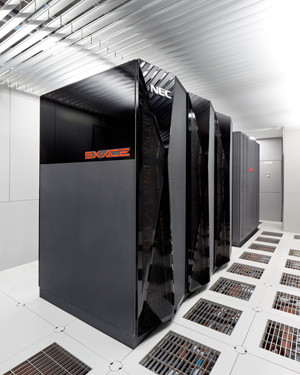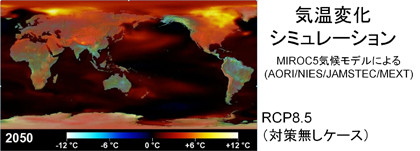
 スーパーコンピュータ
スーパーコンピュータ
(NEC SX-ACE, 2015年6月より稼働)
人間活動による環境の改変が地球の回復力の許容量を超え、取り返しのできない気候変動や環境変化をもたらす可能性があり、それを前もって予測することが重要になっています。残念ながら地球の縮小模型を作って全球にわたる環境再現実験や将来予測はできません。そこで、地球環境の変動メカニズムを研究し、それらを数値的な予測モデルにまとめて、仮想的な地球環境を計算機により構築し、実験をしてみる必要があります。地球環境研究センターでは、地球環境予測モデルなどの研究を支援する目的で、環境情報部と協力し、スーパーコンピュータシステムを整備し、所内外の地球環境研究者に提供しています。
スーパーコンピュータの仕様
スーパーコンピュータは、地球規模での環境変化に関する現象解明や予測などを行うために、1991年度に第1号機を導入し、2013年5月に第5号機に切り替え、2015年6月にメイン機を更新しました。
現在のコンピュータシステムは、ベクトル演算処理を超高速で行う384台(ノード)のベクトル処理用計算機(NEC SX-ACE、演算性能98.3TFLOPS)を中心とした分散型のシステムです。システムの中心となっているベクトル処理用計算機は、地球環境シミュレーションなどの大規模計算に必要な超高速ベクトル演算能力と大容量メモリを有しています。また、スカラー処理用計算機(SGI UV20及びUV30、総理論演算性能43.1TFLOPS)や実効容量1.6PBの大容量ファイルシステムなども導入して多様な計算ニーズや膨大な演算結果の保存に対応しています。これらのシステムは各研究棟を結ぶ所内ネットワーク(1Gbps、一部10Gbps)を通じて利用可能となっており、大容量のデータ転送にも応えられるよう、複数回線を束ねることで回線速度を高めることが可能な構成となっています。
| ノード数 | 384 ノード |
|---|---|
| 総 CPU コア数 | 1536 |
| CPU コア単体ベクトル演算性能 | 64 GFLOPS |
| 最大ベクトル演算性能 | 98.3 TFLOPS (1秒間に98.3兆回の浮動小数点演算が可能)
(1536 CPUコア × 64 GFLOPS) |
| 主記憶容量 | 24 TB |
| ノード間最大データ転送性能 | 8 GB/秒 × 2 (双方向)/ノード |
| OS | SUPER-UX |
| ソフトウェア開発環境 | Fortran/C/C++ コンパイラ
MPIライブラリ など |
| 科学技術計算ライブラリ | ASL、MathKeisan など |
利用研究
スーパーコンピュータの運用研究課題は、所内外の専門家からなる「研究利用専門委員会」の意見を反映させて採択しています。平成27年度には、14課題で利用されています。
また、本システムを利用した地球環境研究の幅広い紹介、利用者間の情報交換などを目的として、研究成果をNIES Supercomputer Annual Report(年報)およびMonograph Reportとして刊行しています。
年報
| 2018 | PDF, 8.1 MB |
|---|---|
| 2017 | PDF, 9.8 MB |
| 2016 | PDF, 7.5 MB |
| 2015 | PDF, 9.3 MB |
| 2014 | PDF, 12.5 MB |
| 2013 | PDF, 11.5 MB |
| 2012 | PDF, 9.7 MB |
| 2011 | PDF, 9.6 MB |
| 2010 | PDF, 10.9 MB |
| 2009 | PDF, 19.0 MB |
| 2008 | PDF, 10.3 MB |
| 2007 | PDF, 7.9 MB |
| 2006 | PDF, 5.6 MB |
| Vol.14 | PDF, 7.8 MB |
| Vol.13 | PDF, 27.9 MB |
|---|---|
| Vol.12 | PDF, 9.6 MB |
| Vol.11 | PDF, 5.6 MB |
| Vol.10 | ZIP, 21.9 MB |
| Vol.9 | ZIP, 6.1 MB |
| Vol.8 | ZIP, 6.8 MB |
| Vol.7 | ZIP, 7.0 MB |
| Vol.6 | ZIP, 4.1 MB |
| Vol.5 | ZIP, 3.2 MB |
| Vol.4 | ZIP, 2.2 MB |
| Vol.3 | ZIP, 2.3 MB |
| Vol.2 | ZIP, 2.8 MB |
| Vol.1 | ZIP, 4.5 MB |
MONOGRAPH REPORT
令和元年度スーパーコンピュータ研究課題および代表者(12課題)
- 全球スケールの陸域モデル開発による気候変動研究
- 横畠 徳太(国立環境研究所)
- 気候感度の外部因子依存性に関する研究
- 塩竈 秀夫(国立環境研究所)
- MIROC5モデルをベースにした海洋結合化学気候モデルの開発
- 秋吉 英治(国立環境研究所)
- 大気汚染物質による環境・気候への影響評価
- 五藤 大輔(国立環境研究所)
- 懸濁粒子の動態および環境負荷物質との相互作用を考慮した沿岸海洋長期環境予測モデルの開発
- 東 博紀(国立環境研究所)
- GOSAT2全球炭素循環モデル開発
- 齊藤 誠(国立環境研究所)
- GOSATデータ処理運用システムにおける確定再処理用参照データの作成
- 亀井 秋秀(国立環境研究所)
- エアロゾルデータ同化を活用した大気汚染予測システムの構築
- 五藤 大輔(国立環境研究所)
- NICAMによる雲降水システムの研究
- 佐藤 正樹(東京大学)
- 系外惑星も含めた惑星気候多様性に関する数値計算: 陸惑星のハビタビリティに関する考察
- 石渡 正樹(北海道大学)
- 季節変化が熱帯準二年振動(QBO)に及ぼす影響
- 柴田 清孝(高知工科大学)
- 大陸から都市スケールでの大気質予測システムの開発と雲・エアロゾル相互作用研究
- 八代 尚(理化学研究所→国立環境研究所)
スーパーコンピュータの利用について
国立環境研究所スーパーコンピュータは、毎年実施される公募に応募し、審査を経て採択された研究課題の課題メンバーのみが利用できます。
2019年度国立環境研究所スーパーコンピュータシステム利用研究の募集について
(2019年1月17日掲載 ※応募期間は終了しました)
スーパーコンピュータ利用研究報告会
スーパーコンピュータの利用研究課題は、毎年秋に開催されるスーパーコンピュータ利用研究報告会にて中間報告並びに事後報告を行っています。この報告会は全国の利用研究者間の貴重な情報交換の場でもあり、毎年多くの方々にご参加いただいております。以下に、終了した利用研究報告会のプログラムと発表要旨および発表資料(発表者より希望があった課題のみ)を掲載しています。
- 平成30年度 (平成30年12月26日開催)
- 平成29年度 (平成29年12月25日開催)
- 平成28年度 (平成28年12月20日開催)
- 平成27年度 (平成27年11月30日開催)
- 平成26年度 (平成26年12月24日開催)
- 平成25年度 (平成25年12月19日開催)
- 平成24年度 (平成24年12月11日開催)
- 平成23年度 (平成23年11月25日開催)
- 平成22年度 (平成22年11月9日開催)
- 平成21年度 (平成21年11月11日開催)
- 平成20年度 (平成20年11月28日開催)
研究成果の例
スーパーコンピュータシステムは、大気や海洋における複雑な自然現象の再現や予測を長期かつ全球的にシミュレーションすることや、地球上の生物個体や環境の情報を過去から現在にわたり蓄積して解析する膨大な処理に使われるなど、地球環境の中で起こるさまざまな現象・問題を扱う研究に利用されています。
将来の地球温暖化により地表付近の気温がどのように変化するか、気候変動に関する政府間パネル(IPCC)が想定している最新シナリオ毎に数値シミュレーションを行いました。また、福島第一原子力発電所事故の結果放出された放射性物質の海域での動態解明と将来予測など、幅広い分野で大きな成果を上 げています。





